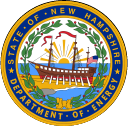News
Contact
Default Energy Service... Why these fees?
What’s the deal with default energy service? By Michael J. Crouse
Have you ever flipped your light switch on and thought, gee, I wonder where my electricity comes from? How come electricity costs so much? Chances are, if you are from New Hampshire and are a residential customer, you get your electrical supply from a utility instead of an unregulated competitive electricity supplier. That’s what we call default energy service. But where does a utility’s electricity come from? Utilities get their default energy supply from wholesale electricity suppliers through a procurement method called a request for proposals (“RFP”) but more to that later. Unregulated suppliers also tend to offer electricity supply services directly to residential customers in a utility’s franchise area (their service territory) as an alternative to default energy service.
But this will likely make you ask, isn’t this all the same electricity? Should I go through the utility or one of these other suppliers directly? To answer that question, you should first ask yourself, do you know how much you are currently paying for electricity?
Default service energy has gotten expensive in the past two years. The norm in NH a few years ago was 10 cents per kilowatt hour (“kWh”). We are now in the ugly era of 22 cent kWh. Unitil charges 26 cents kWh, Liberty is 22 cents kWh, Eversource is at 20 cents kWh, and the New Hampshire Electric Cooperative (“NHEC”) is at 13 cents kWh.
Why these fees? Or, as The Consumer Advocate Don Kreis memorably abbreviated it, WTF? How can the NHEC keep prices so low while the utilities have high prices? Why is the NHEC half the rate of Unitil?
The reason the NHEC can keep prices low while the investor-owned utilities have high prices is because of active portfolio management. Investor-owned utilities, like Eversource, Liberty, and Unitil, currently issue RFPs for all-requirements service to procure their default energy supply — RFPs of this type amount to inactive portfolio management. And the reason for passive management is that a utility does not generate a profit off default service procurement, but it is allowed to recover the procurement costs. Here, the utilities have no incentive to protect the ratepayers’ interest, because the investor-owned utilities make no money on the deal while recovering all their costs.
Simplifying the process somewhat, right now each investor-owned utility issues an RFP every six months and takes whatever price happens to be currently available. This chance for peaks and valley pricing is what the OCA refers to as the luck mechanism. If pricing is low, residential customers benefit, whereas the inverse is also true. However, the NHEC is a deregulated utility (having filed a certificate of deregulation with the PUC, as authorized by law). Therefore, it can use any procurement method that suits the NHEC’s needs. And because the NHEC is owned by its customers, there is a lot of incentive to keep costs low. So, the NHEC does what any reasonable person would do — it diversifies its procurement. That could mean choosing among laddering (making sure their supply contracts do not all expire at once), the RFP process, or a combination of those approaches as well as other alternatives.
In the other utilities’ defense, they are under orders from the PUC to procure their default energy service through RFPs. These orders mean that the utilities cannot simply decide on their own to manage their default energy procurement actively. However, there is nothing to stop a utility from petitioning the PUC to allow the utilities to manage their default energy procurement actively.
If you’re starting to get interested and want to learn what all the major players — the utilities, the PUC, the OCA, etc. — have to say, check out PUC docket IR 22-053! Dockets are an electronic filing cabinet where you can find all these legal documents that dive deep into this topic.
And if you’re still asking yourself “WTF”? What can I do if I am paying 26 cents kWh for the same supply of energy my neighbors at the NHEC are paying 13 cents kWh for… there’s hope!
There are a couple of solutions that you can start doing right now. First, you can start shopping for a competitive supplier caveat emptor —a fancy way of saying “let the buyer beware.” Second, you can look into getting your municipality to jump on the community power bandwagon. Why not take a moment to read about the Community Power Coalition of New Hampshire (“CPCNH”) here? Or look at an alternative example with the City of Keene working with Good Energy and Standard Power here. Third, you can ask yourself, how energy efficient am I? You can read about NHSaves to learn more about energy efficiency and potential savings.
Energy efficiency is important because it just means getting more value out of every unit of energy consumed. How? Consider home weatherization improvements — like insulating walls, weather-stripping doors, or installing heat pumps. You can reduce your monthly energy bill by making your home more energy efficient.
But how can I make these improvements more cost-effective? NHSaves partners with utilities like Eversource, Liberty, Unitil and the NHEC where you can take advantage of incentives like rebates of up to $6,000. New Hampshire also offers a Weatherization Assistance Program (“WAP”) that allows eligible low-income households to receive assistance with these types of energy efficiency improvements to offset rising costs.
And now you know. Please feel free to contact me if you’d like to chat about any of this. My contact info is above.



